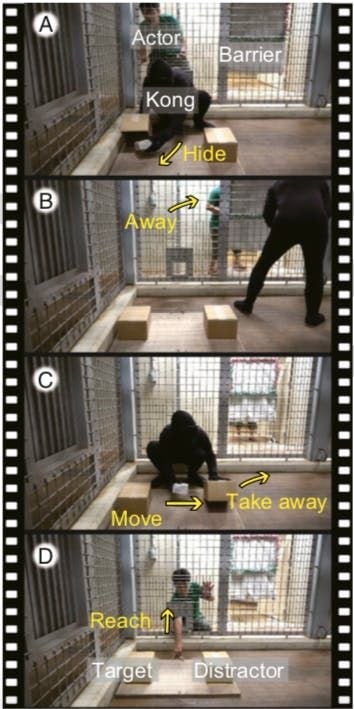Great Apes May Use Their Own Experience to Guess What Others Will Do
New research suggests primates possess ‘theory of mind’, an ability once thought to be unique to humans
/https://tf-cmsv2-smithsonianmag-media.s3.amazonaws.com/filer/e6/a2/e6a2b95b-03e6-471a-a8aa-1242415a615b/1024px-500px_photo_188689983.jpeg)
A new survey of 47 chimpanzees, bonobos and organgutans suggests great apes draw on personal experience to infer others’ actions, exhibiting a skill once thought to be unique to humans.
As researchers led by Fumihiro Kano of Japan’s Kyoto University report in Proceedings of the National Academy of Sciences, the findings add to a growing body of evidence indicating non-human animals possess “theory of mind,” or the ability to attribute mental states—including beliefs, desires and knowledge—to oneself and others.
According to Cosmos’ Tanya Loos, the study builds on a 2016 investigation also co-authored by Kano. The previous paper, published in the journal Science, showed that great apes are capable of recognizing when others are operating under a false set of assumptions—a key component of theory of mind.
To determine primates’ capacity for understanding false belief, Kano, lead coauthor Christopher Krupenye of Duke University and their colleagues conducted a series of anticipatory looking tests. In the 2016 experiment, great apes watched videos of humans—one dressed as a gorilla—hiding an object and then guessing where it was. One video showed the gorilla-suit actor hiding an object while another human watched. The person then had to guess where the object was hidden. A second video showed the gorilla-suit actor hiding an object after the other human left the room. When the person returned, they had to guess where the object was hidden.
In total, 17 of 22 apes tested—as judged by their eye gaze—correctly predicted that the subject would search in the original hiding place if the item was moved without their knowledge.
As Cosmos’ Loos reports, the latest study corrobates the 2016 findings while challenging a proposed explanation for the great apes’ accurate assessments. The previous work suggested that the animals followed the so-called “behavior rule,” which means the great ape probably just chose the last location seen, rather than genuinely comprehending the agent’s state of mind.
To debunk the behavior rule explanation, Kano and his fellow researchers used a revised version of the original 2016 experiment. According to Cosmos' Loos, the apes were first familiarized with opaque and translucent barriers.
Then the researchers repeated the video trial while the apes wore a visual tracking device and sipped juice. The great apes watched an actor dressed like a monkey—nicknamed Kong—hide an object underneath one of two identical boxes as another human actor watched. Next, the actor stood behind a barrier while Kong moved the item. While moving the object, Kong first switched it from the original “target” box to the second “distractor” box and then removed it completely. When the other actor returned, they paused between both boxes for several seconds before ultimately choosing one.

Apes shown an opaque barrier focused their gaze on the target box, operating under the assumption that the human actor would search the area in which they had last seen Kong hide the object. Those shown a translucent barrier, meanwhile, exhibited no preference, instead acting as if the subject knew the object had been removed and would therefore not search in any specific location. Hypothetically, the apes were recalling their experiences with barriers and assuming the human was experiencing the same thing. (Or as the idiom goes, the apes were able to "take a walk in their shoes," or put themselves in that situation based on prior knowledge and apply it to what the actor experienced.)
Per a press release, the findings refute a purely behavioral explanation because both groups of great apes anticipated the actor’s decisions based on their personal experience with the barriers rather than just following Kongs’ actions.
“These results together corroborate the idea that … nonhuman animals have a theory of mind and do not simply rely on behavior rules to interpret and anticipate others’ actions,” the authors write in the study.
As Kano concludes in the press release: “We are excited to find that great apes actually passed this difficult test. The results suggest that we share this ability with our evolutionary cousins. We plan to continue refining our methods to test further non-mentalistic alternatives to the theory of mind in nonhuman animals.”
/https://tf-cmsv2-smithsonianmag-media.s3.amazonaws.com/accounts/headshot/mellon.png)


/https://tf-cmsv2-smithsonianmag-media.s3.amazonaws.com/accounts/headshot/mellon.png)